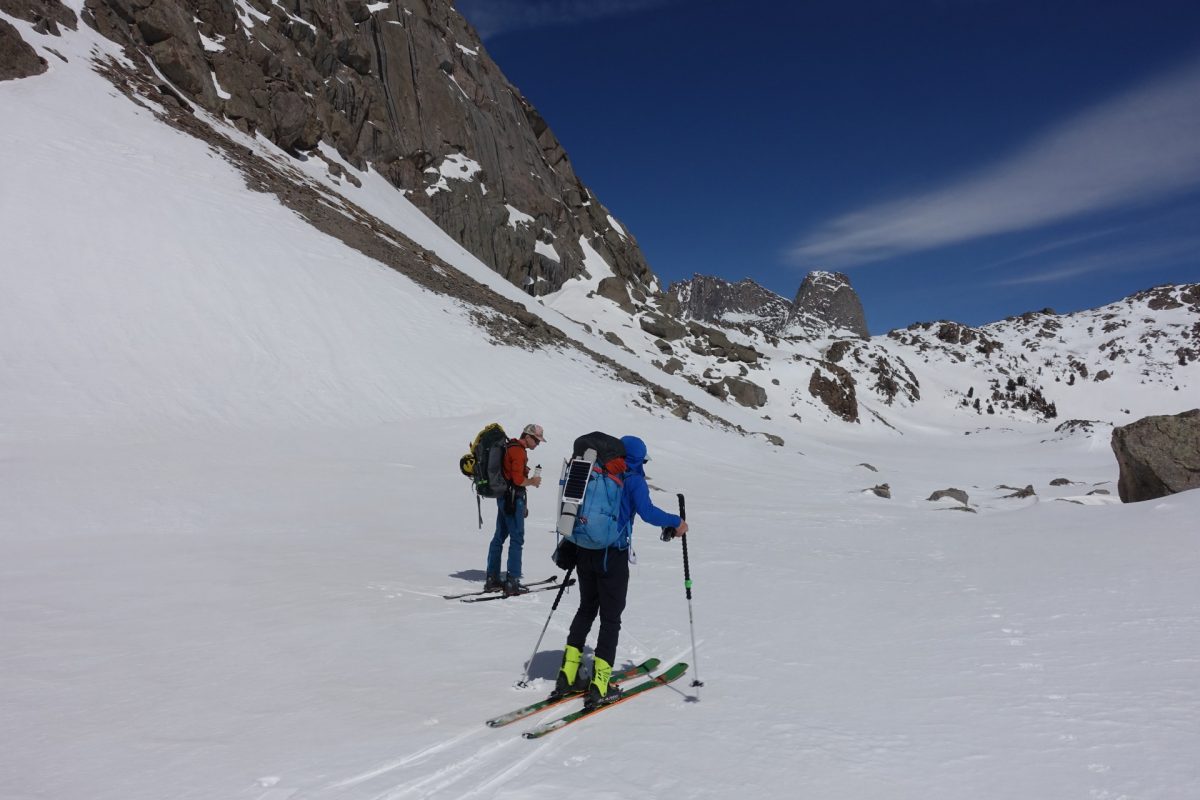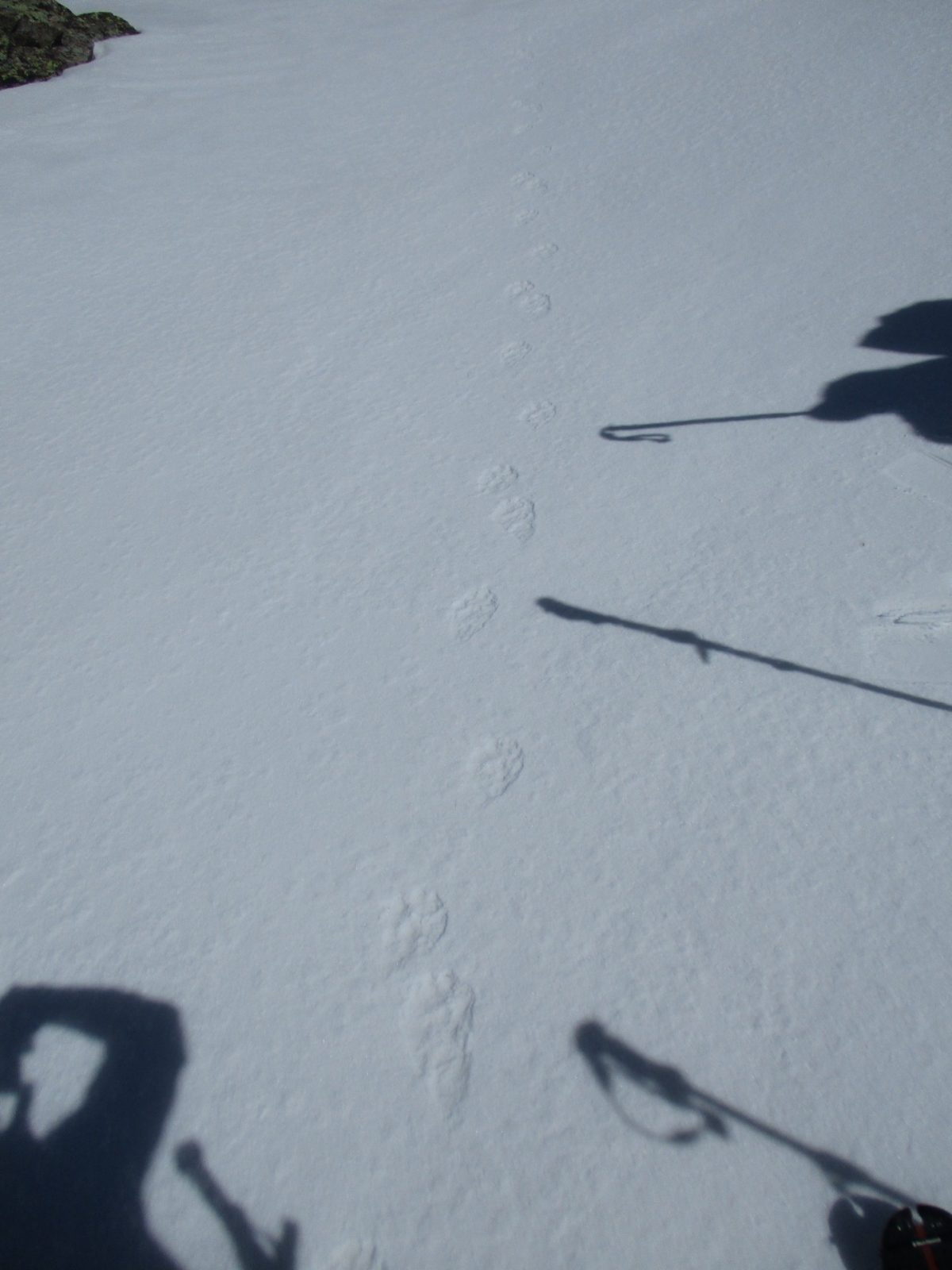With more winter backcountry users and a scarcity of good snow and terrain, is it time for a unified voice to mitigate conflicts?
Since last fall, WildSnow has covered in some detail the ongoing challenges of managing Teton bighorn sheep and winter backcountry access. As proponents of silent sport, I think it’s tough to imagine our relatively benign pursuit as disruptive.
All the words, interviews, and map analysis to learn more about the sheep/winter backcountry access issue had me tunneling down several rabbit holes. As winter backcountry use proliferates, sheep may not be the only canary in the coal mine. In the Wind Rivers this May, large tracks ascending towards Jackass Pass startled me; they seemed bear-sized. One of my partners on the traverse, who’s knowledgeable about things game and fish, said, “wolverine.”
Those storied and elusive animals are known to travel crazy distances and occupy massive home ranges. We eventually lost the tracks as we dropped into the Cirque of the Towers and skinned towards Texas Pass.

Jackass Pass in the distance, the skin line follows a wolverine track towards the Cirque of the Towers in the Wind Rivers.
Short story; after reporting on the Teton bighorn sheep winter backcountry travel survey results on July 8, I became curious about what other wildlife might be impacted by winter backcountry users. What comes next is speculation, but my readings on wolverines (which lack protections under the Endangered Species Act) and learning about their sensitivity to human disturbances got me thinking of what ski zones might be off limits next.
The op-eds we published on the Teton sheep, pro and con, raised interesting points about how we as a community can be participants and problem solvers on issues of winter backcountry access. But, what appears to matter is being organized and thoughtful and knowing when to take hard stances and make compromises, even when it means limiting our access to world-class ski terrain.
With that in mind, let’s take a quick look at some advocacy groups involved with winter backcountry access issues.
The Teton Backcountry Alliance:
Mission Statement: Teton Backcountry Alliance (TBCA) is a grassroots organization dedicated to Teton-area winter backcountry recreation and recreationist effects on our environment, wildlife, and other people. Our mission is to promote public safety, community, stewardship, and sustainable access for Teton-area winter backcountry users. TBCA addresses these goals through dialogue, public information, problem solving, and advocacy. Launched in 2017, TBCA is currently focused on maintaining winter backcountry use on Teton Pass, mitigating bighorn sheep-skier interactions, and educating stakeholders about proposed local ski area expansions.
Wasatch Backcountry Alliance:
Mission Statement: “Wasatch Backcountry Alliance (WBA) is the recognized voice for the backcountry community involved in human-powered winter recreation in the Central Wasatch Mountains. We represent a unified voice to media, partners, elected officials, and the general public. We focus on providing advocacy to support our causes, and serve as a central information venue for related topics.”
Current advocacy involves a full court press regarding proposed actions to alleviate traffic congestion in Little Cottonwood Canyon, which includes a proposed gondola. WildSnow will report on this issue next month, but the WBA’s The Uptrack podcast provides all the background you’ll need to catch up on the issue.
Tahoe Backcountry Alliance:
Mission Statement: “The Tahoe Backcountry Alliance is the voice for the human-powered winter backcountry community in the Lake Tahoe area, advocating for and informing our community about critical issues affecting winter backcountry recreation in and around Tahoe.”
You can find more information on the TBA’s current projects here.
Granite Backcountry Alliance:
Partial mission statement: “GBA resolves to improve the playing field for backcountry skiers. Creating and developing ski glades, however, is not the only objective of the group. Improving the foundation of the sport is critical to future success, such as creating partnerships and collaboration with public and private landowners, education regarding safety and ecological awareness, and creating a unified culture – one that respects the land and its owners and does not permit unauthorized cutting. Read the full mission statement here.”
The GBA is involved in creating glade skiing in the Northeast.
I know, not an exhaustive list in the least. Please infill in the comments if you know of a backcountry ski/riding advocacy group that readers should be aware of.
Do we need a collective voice?
My primary ski partner wrote an op-ed for WildSnow months ago; give it a read: “Where We Ski: A Federal Lands Primer.” Like many things WildSnow, the comments added depth to the discussion. We’ll get back to the comments in a few. But first, an admission of sorts. I purchased a 2011 Skidoo snowmachine last fall. In total, I machined into a wilderness boundary on eight occasions last season. Before that, I received a motor-assisted tow four times (all within the previous two years). Ask John, the author of the op-ed noted above; I was an anti-sled zealot for years. Considering their din, we referred to snowmachines/sleds as Orks when we heard them on our tours. I suppose, for the time being, I’ve joined the ranks of the Orks. Adding to my footprint, I’ve been backcountry skiing since 1992; I usually drive a car to access skiing.
I believe in our concept of Wilderness. I believe in finding silence too. So no motors in specific zones aligns with my values. And maybe I’ve backed myself into a corner here by owning a snowmachine, and am a hypocrite.
I also believe we are at a point where perhaps we should build alliances with those outside our echo chamber. I’ve met plenty of kind snowmobilers as I’ve skinned into the backcountry. I’ve met kind backcountry skiers and split boarders, but it goes both ways; I’ve met not-so-kind skiers/riders and sledders. The issues involving Wilderness and non-wilderness and who gets to use these areas are complex. And they should be treated as such. The idea of Wilderness seems straightforward and reasonable — no motors. It gets spicier in non-wilderness where skiers, split boarders, and sledders share the terrain or must coexist in close proximity.
And clearly, with the Teton bighorn sheep issue coming to a head soon, wildlife concerns and our impact on them should also be part of the discussion. What exactly are we willing to give up regarding access to ski terrain if it helps protect wildlife? For those of us well beyond the Teton region, it’s time to consider how we would address a similar issue in our home mountain ranges.
Let’s get back to the comments from the primer on federal lands. Our own A.K. Mattix got me thinking about advocacy groups with broad versus narrowly focused missions and what serves the interests of the local backcountry community. (Read his full comment). In short, Mattix quotes the axiom, “if you are not at the table, you are on the menu.”
And Lou Dawson, in his comment, plopped another axiom into play, “he or she who divides gets the smallest share.”
I’m speaking to backcountry skiers/riders here, even those like myself who have accessed terrain riding a sled or been towed. Learning more about the Teton sheep and reading up on other potential issues that could impact my access to fine backcountry terrain has me asking this question: do we need a collective voice?
Jason Albert comes to WildSnow from Bend, Oregon. After growing up on the East Coast, he migrated from Montana to Colorado and settled in Oregon. Simple pleasures are quiet and long days touring. His gray hair might stem from his first Grand Traverse in 2000 when rented leather boots and 210cm skis were not the speed weapons he had hoped for. Jason survived the transition from free-heel kool-aid drinker to faster and lighter (think AT), and safer, are better.


